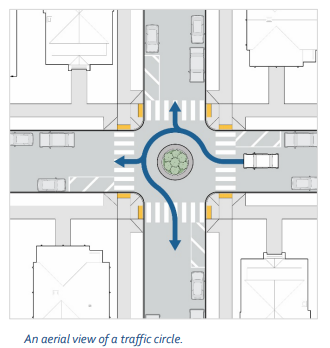Traffic Circles
Purpose 
Traffic Circles may be used to reduce vehicle speeds at intersections on neighborhood streets with uncontrolled, stop-controlled, or yield-controlled approaches.
Description
Traffic circles are a type of circular intersection that vary in size and are different than roundabouts. They are circular raised islands in the center of intersections designed to slow passenger vehicles while still allowing for larger vehicle and emergency vehicle access. They are best used on neighborhood streets where a full-sized roundabout is not appropriate and are also known as neighborhood traffic circles, neighborhood mini-circles, or mini-traffic circles.
Safety Objectives and Benefits
- Reduces vehicle through speeds by forcing motorists to maneuver around the island.
- Eliminates left turn crashes.
Street Types and Context
Applicable Street Types
Local Principal and Local Minor streets.
Other Location Guidance
- Intersections with one travel lane in each direction.
- Roadways with posted speeds of 30 mph or less.
- Residential streets.
- Neighborhood bikeways.
- Stop-controlled intersections with high delay.
Primary User Groups

Key Implementation Considerations
- Signage should direct traffic flow and make islands visible to motorists.
- May be landscaped with low shrubs or vegetation that does not impede visibility.
- Additional considerations needed for routes with transit, trucks, or other large vehicles. Large vehicles, such as emergency response vehicles or school buses, may need to make left turns at intersections preceding the traffic circle.
- To allow for emergency-response vehicle access, restrict parking on approaches to the traffic circle or create mountable curbs on the outside of the traffic circle.
- Ensure clear sight lines on approaches by restricting parking if needed.
- New traffic circles are typically only considered for locations that do not have all-way stop control.
Expected Crash Reduction
A CMF has not been developed, but initial research indicates traffic circles can reduce vehicle speeds (Ewing 1999) and crashes (Thomas et al. 2015).
Cost

Varies, but likely between $5,000 and $15,000. Traffic circles are lower in cost to install if no other curb changes in the intersection are needed. If curbs must be adjusted, and there are changes to drainage structures and curb ramps, the cost will be higher.
Timeline

One to three years or more, depending on materials.
Application in Arlington
Visit Vision Zero Program Dashboard: Traffic Circle to see where this tool has been implemented.
Vision Zero Dashboard
References
